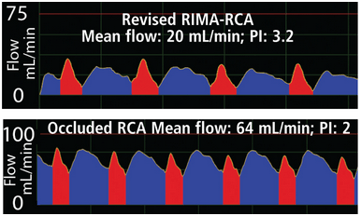Is a Graft Bad When Mean Bypass Flow Is Lower Than Expected?
Flow-based intraoperative bypass graft patency assessment during CABG confirms a graft’s flow-carrying capacity to prevent early graft failure. But sometimes bypass graft flow does not meet expectations. Where would you look if, after you have constructed a graft and measured flow, the graft flow is less than one would anticipate given the health and size of the conduit and the physiology of the patient?
Assessing Native Coronary Flow
The answer is to first check for competitive flow from the native coronary. Competitive flow reduces graft flow. It therefore reduces the predictive value of graft flow as a measure of graft patency. If the native coronary artery is not fully stenosed and a bypass graft is placed, blood flow from the native coronary artery literally “competes” with and lowers bypass flow. Assessing competitive flow during CABG informs surgeons and facilitates their subsequent graft patency decision making.

Although it is optimal to assess competitive flow immediately when bypass graft flow is measured, it is more practical to check for competitive flow only if mean bypass flow is less than expected or in the questionable range.
Checking for Competitive Flow
To check for competitive flow, two consecutive flow measurements are recommended: one without occlusion of the native coronary artery; and a second with occlusion. If occlusion fails to increase graft flow, a 100 percent native coronary artery stenosis is indicated. Subsequent graft flow measurements can then be made without further coronary occlusion. If occlusion of the native coronary produces a higher graft flow reading, competitive flow from the native coronary is present. In such instances, the analysis of graft patency should be based only on flow observations taken with full coronary occlusion.
One clue for the presence of competitive flow is a short negative pulse in the systolic phase of the flow waveform (retrograde flow). Such a negative flow pulse will occur, typically, at the onset of systole, but may occur at the end of systole as well. The absence of a negative pulse does not rule out the possibility of competitive flow.

The above example demonstrates an example of competitive flow. Flow in the RIMA-RCA graft was 20 mL/min. The PI was 3.2, but the surgeon was suspicious. He expected a higher flow given the size of the patient. Suspecting the presence of competitive flow from the native RCA, the surgeon occluded the native RCA proximal to the anastomosis. Mean graft flow increased to 64 mL/min with a PI of 2. Runoff improved, competitive flow decreased an the graft flow was > 40 mL/min. The dramatic increase in mean graft flow confirmed the surgeon's suspicion that competitive flow was suppressing graft flow.




